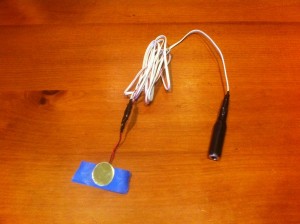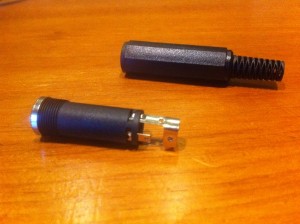I have several acoustic stringed instruments. I’m not very good at playing any of them, but I have a lot of fun trying. Mandolin, ukulele, banjo, and a handful of guitars.
When playing with a drummer or trying to get a recording, it’s nice to be able to plug in an instrument and get some extra volume. Plus, with an electrified instrument you can always add pedals, post-processing, and other effects to alter the sound a bit.
I’ve done a permanent install of an under-saddle pickup on a guitar before, but I didn’t want to spend the time or money on each instrument to get all the instruments upgraded.
I’d heard about homemade piezo-transducer pickups before, so I thought I’d see if I could make one my own. Sure, you can buy cheap ones, but where’s the fun in that?
So, I made one myself. Total cost was under $6. Here’s the finished product, in all it’s DIY glory:

Parts list
1. Piezo transducer. Radio Shack part number 273-0073.
2. 1/4″ mono jack. Radio Shack part number 274-0340.
3. A length of 2-conductor wire. I used some leftover 18-gauge wire from a garage door opener.
4. Some electrical tape.
5. Some blue painters tape.
Tools aren’t required, but a wire stripper and a solder gun are useful.
Assembly instructions
1. Remove the transducer from the plastic housing. I used a small slotted screwdriver to pry the top off. Be careful, or plan on another trip to Radio Shack and another $3.

2. Strip insulation from both conductors on each end of the wire.
3. Connect the two leads from the transducer to the two conductors on one end of the wire. Insulate bare wires with electrical tape.
3. Disassemble the jack.

4. Slide the jack housing over the other end of the wire.
5. Connect the conductors on that end of the wire to the two connection points on the jack internals. Solder or tape the conductors in place.
6. Screw the jack housing onto the jack internals.
Connecting the pickup to the instrument
I used blue painters tape to affix the transducer to the top of my mandolin, just below the bridge. Test out several locations on the top and back of the instrument for best sound.
On my ukulele, the best-sounding location was on the back:

When finished, plug in, grab a beer, and bask in your electrified awesomeness.
If you’re bored, listen to my first electric mandolin recording experiment: Ashokan Farewell, recorded as two A/B inverted parts using my standard recording tools.